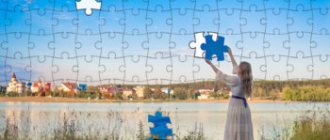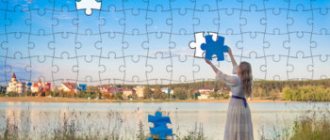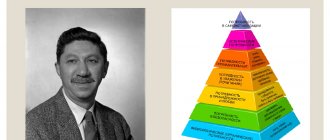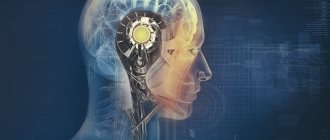Imagination is the process of creating images of objects and phenomena that have never been perceived by a person before.
Imagination is a necessary element of creative activity, expressed in the construction of an image of the final and intermediate products of labor, and also ensures the creation of a program of behavior in cases where the problem situation is characterized by uncertainty. Those. imagination allows you to imagine the result of work before it begins, to imagine not only the final product, but also intermediate results.
Imagination is closely related to thinking. Just like thinking, imagination arises in a problem situation, i.e. when you need to find a new solution. But the advanced reflection of reality in the process of imagination occurs in the form of vivid ideas, and the advanced reflection in the process of thinking occurs by operating with concepts. If the initial data of a problem are known, then the course of its solution is subject primarily to the laws of thinking (for example, a scientific problem).
If the problem situation is characterized by uncertainty and the initial data is difficult to accurately analyze, then mainly the mechanisms of imagination come into play (for example, the work of a writer). Fantasy allows you to “jump” over some stages of thinking, when the necessary completeness of knowledge is missing, and still imagine the end result. Although sometimes the solutions outlined by imagination are not accurate enough.
Imagination is closely related to perception and memory, because... imagination is always built on processed material from past perceptions that a person has remembered. For example, when creating an image of a desert, a person relies on past experience (he knows what sand is, he saw a camel in a picture or in a zoo).
Processes of creating images of the imagination.
The technology for creating imaginative images is of an analytical-synthetic nature, i.e. carried out using analysis and synthesis. A person dismembers a previously established system of ideas and creates new images on this basis. Even if you come up with something completely extraordinary, then upon careful examination it will turn out that all the elements from which the fiction was formed are taken from life, are the results of an intentional or unintentional analysis of countless facts.
But analysis and synthesis when creating images of the imagination can be carried out in various forms.
1. Agglutination (translated from Greek as gluing) is a combination of various qualities, properties, parts characteristic of two different objects. Many fairy-tale images are constructed through agglutination (mermaid, hut on chicken legs, centaur). This technique is also used in technical creativity (an amphibious tank combines the qualities of a tank and a boat, an accordion combines a piano and button accordion, a trolleybus).
2. Hyperbolization (hyperbole - increase an object, lithol - decrease) - an increase or decrease in objects, or a change in the number of parts of an object (a giant, Thumb, many-armed goddesses in India, a dragon with seven heads, a one-eyed Cyclops).
3. Emphasis – sharpening of any features (friendly cartoons or evil caricatures).
4. In the event that the ideas from which the image of fantasy is constructed merge, the differences are smoothed out, and similarities come to the fore, this contributes to the implementation of schematization (the artist’s creation of a national ornament, the elements of which are taken from the plant world; the image of an Italian, an American and etc.).
5. Typification – used in fiction, sculpture, painting; What is characteristic here is the identification of the essential, repeated in homogeneous facts, and the embodiment of this in a specific image.
Types of imagination
Based on the degree of activity in the process of creating new images, two types of imagination are distinguished: active and passive.
Active imagination arises from human needs and stimulates his creative and practical activity. An active imagination can be creative and reconstructive.
Recreating is the recreation of images of existing objects, the creation of images that correspond to the description.
Creative is the independent creation of new, non-existent images in the process of activity (discoveries in science, inventions in technology, creation of works of art). Creativity is the work of both memory and thinking.
Imagination is also necessary in pedagogical activity (pedagogical creativity). The teacher must be able to foresee a complex of reasons that determine the behavior of students, anticipate the course of the lesson, and predict the reactions of students. In addition, education is the design of personality, the creation of an ideal image, but on an individual basis.
Passive imagination is when fantasy creates images that are not realized, outlines behavioral programs that are not implemented and often cannot be implemented. Passive imagination can be intentional or unintentional.
Intentional imagination occurs when images arise as a result of a person's special intention. Intentionally evoked images that a person does not strive to bring to life are called dreams. All people tend to dream about something joyful, pleasant, and tempting. But if dreams predominate in the process of imagination in a person, then this is a defect in personality development. For such people, imagination acts as a substitute for reality: a person goes into the realm of fantastic ideas in order to hide from difficult conditions and insoluble problems.
Unintentional imagination occurs when the activity of consciousness weakens without a person’s special intentions. For example, in a half-asleep state, in a state of passion, in a dream, with pathological disorders of consciousness (hallucinations).
A special type of imagination - a dream - is the creation of images of the desired future. Unlike dreams, a dream acts as a motivating force for activity.
The sensitive period for the development of imagination is preschool age, because... The leading activity here is the game, and the necessary element of the game is an imaginary situation, introduced using the words “as if.” Role-playing games provide rich food for the imagination, which allows not only to assimilate social experience, but also deepen and consolidate valuable personality traits (courage, determination, organization, resourcefulness). Although it is still too early to talk about real creativity in preschool age, because... not enough experience.
Emotions and feelings, properties and types of emotions.
When a person perceives objects and phenomena of the surrounding world, he always relates to them in some way and experiences certain feelings. Some events cause him joy, others - indignation, he likes some things, others don’t, he loves some people, hates others, and is indifferent to others.
Feelings are a person’s internal attitudes to what is happening in his life, what he knows or does, to other people and to himself, experienced in various forms.
Emotions are physical states and processes that arise as a result of the action of significant phenomena and situations on an individual and manifest themselves in the form of direct experiences.
Emotions and feelings for a person are an indicator of how the process of satisfying needs occurs. A person compares information about what is required to satisfy a need with what he has at the time of its occurrence. If the likelihood of satisfying a need is high, positive feelings appear. Negative emotions are generated by the inability to satisfy a need or by a drop in its probability compared to the forecast that the subject gave earlier.
Functions of emotions and feelings:
1. Reflective (allows you to determine the usefulness or harmfulness of an event).
2. Incentive (the emotional experience contains an image of an object and a biased attitude towards it, which encourages a person to act).
3. Reinforcing (significant events are imprinted in memory faster and for a long time).
4. Switching (discovered when there is a competition of motives, as a result of which a dominant need is determined).
5. Adaptive (thanks to emotions, the significance of certain conditions for meeting current needs is established, so the body can effectively adapt to certain environmental conditions).
6. Communicative (facial expressions and pantomimes allow a person to convey his experiences to other people). Thanks to this function, a person can influence other people.
Basic ways to create images
There are several of them, but each of them characterizes the concept of imagination in psychology as a rather complex, multi-level process.
- Agglutination. By assessing and analyzing the qualities, properties and appearance of a particular object, we create in our imagination a new, sometimes bizarre image, far from reality. For example, in this way the fairy-tale character Centaur (the body of a man and the legs of a horse), as well as Baba Yaga’s hut (a house and chicken legs), and an elf (a human image and insect wings) were invented. As a rule, a similar technique is used when creating myths and tales.
- Emphasis. Isolation of one dominant characteristic in a person, object or activity and its exaggeration. This method is actively used by artists when creating caricatures and caricatures.
- Typing. The most complex method, based on highlighting the features of several objects and creating a new, combined image from them. This is how literary heroes and fairy tale characters are invented.
Expression of emotions and feelings.
Often the words “emotions” and “feelings” are used as synonyms. But emotions are situational. Emotions are the immediate, temporary experience of a feeling. For example, an emotion is not the feeling of love for music itself, but the state of admiration that a person experiences at the moment while listening to a concert.
Emotions and feelings can be positive or negative in quality. But sometimes negative emotions can have a positive connotation (anger at a bad deed). And sometimes it is possible to experience opposite emotions (“I’m sad and easy,” Pushkin). This phenomenon is called ambivalence (duality) of feelings (love and hatred with jealousy).
Emotions and feelings can also be viewed from the point of view of whether they cause an active or passive state. If emotions motivate actions, statements, or increase the tension of forces, they are called sthenic (from the Greek “stenos” - strength). For example, a person is ready to “move mountains.” Joy, anger, hatred are sthenic emotions. If the experience of emotion is characterized by passivity and relaxes a person, then they speak of asthenic emotions (“asthenos” - weakness).
As they say, “your legs give way.” Sadness, melancholy, despondency are asthenic emotions. But for some people the same emotions can be experienced as sthenic, for others as asthenic. For example, the emotion of fear can cause a helpless state in one person, and a violent reaction in another.
According to the form of flow, the whole variety of emotions and feelings can be divided into emotions (in the narrow sense of the word), affects, moods, frustration, stressful conditions, higher feelings, passions, hobbies. These forms of experiencing emotions and feelings form the emotional sphere of the individual.
Emotions (in the narrow sense of the word) are the direct experience of a feeling.
The following “fundamental emotions” (according to K. Izard) or basic emotional states are distinguished:
1. Interest is a positive emotional state that contributes to the development of skills and knowledge.
2. Joy is a positive emotional state associated with the opportunity to satisfy an urgent need, the likelihood of which was low until this moment.
3. Surprise - does not have a clearly defined positive or negative sign, occurs suddenly, inhibits all previous emotions and directs attention to the object that caused it. It can turn into interest.
4. Suffering is a negative emotional state associated with reliable or apparent information about the impossibility of satisfying the most important needs of life, which until this moment seemed more or less probable. They are asthenic in nature.
5. Anger is a negative emotional state caused by a sudden serious obstacle to the satisfaction of an extremely important need. Has a sthenic character.
6. Disgust is a negative emotional state caused by objects (people, objects, circumstances), contact with which (physical interaction, communication, etc.) comes into sharp conflict with the moral or aesthetic principles of the subject.
7. Contempt is a negative emotional state that arises in interpersonal relationships and is generated by a mismatch between the life positions of the subject and the life positions or behavior of the object itself.
8. Fear is a negative emotional state that manifests itself when the subject receives information about possible damage to his well-being in life, about a real or imagined danger that threatens him. It has both sthenic and asthenic character.
9. Shame is a negative emotional state, expressed in the awareness of the inconsistency of one’s own thoughts and actions not only with the expectations of others, but also with one’s own ideas about appropriate behavior.
Affect – (from Latin аffectuctus – emotional excitement) a strong and short-term emotional state associated with a change in life circumstances that are important to a person. It is characterized by a change in consciousness, a violation of control over actions, and a loss of self-control. It quickly takes hold of a person and proceeds violently. The effects are short-lived, because cause a huge expenditure of effort. If an ordinary emotion is emotional excitement, then affect is a storm, an explosion.
A person loses control over himself, committing reckless actions, and then he may regret it and remember it as if in a dream. After an affective outburst, weakness and loss of strength sets in. Any emotion can develop into affect: joy into delight, anger into anger, fear into horror, suffering into despair. We can say that affect is bad or good depending on what emotion the person is experiencing. A person can control affect and restrain its onset in the early stages.
Mood is a general emotional state that colors all human behavior for a long time (joyful, sad, serious, frivolous, cheerful, lethargic). Usually the mood is not consciously realized by the person, but sometimes it has significant intensity and leaves an imprint on both mental activity and work productivity (everything goes wrong).
Mood is an individual’s unconscious assessment of how favorable circumstances are for him. Sources of mood: satisfaction or not with the course of life, affairs at work, in the family; health status, weather, etc. Moods also vary in duration. It depends on: age (in children it changes quickly), character, temperament, willpower, etc. Mood influences behavior and stimulates or inhibits activity.
Stress - (from the English stress - pressure, tension) occurs in unusually difficult situations and is experienced with great internal tension. In terms of its psychological characteristics it is close to affect, and in terms of its duration - to mood. May be sthenic or asthenic in nature (example with the exam). Occurs when there is danger, great physical and mental stress, etc. Stress can be physiological and mental.
Psychological stress, in turn, is informational (a person cannot cope with a task, does not have time to quickly make the right decision with high responsibility) and emotional (threat, danger, resentment). Different people experience stress differently (“lion stress”, “rabbit stress”). According to their orientation, they distinguish stress (positive orientation, ensures the mobilization of body systems, for example, in case of danger) and distress (negative orientation, is destructive, leads to exhaustion of the body).
Close in its manifestations to stress is the state of frustration.
Frustration is (from Latin frustratio - deception, frustration, destruction of plans) a human state caused by objectively insurmountable (or subjectively perceived) difficulties that arise on the way to achieving a goal. Frustration is accompanied by a whole range of negative emotions that can disorganize consciousness and activity.
In a state of frustration, a person may exhibit anger, depression, external and internal aggression, frustration, motor agitation (purposeless and disordered movements), and apathy. The level of frustration depends on the strength and intensity of the influencing factor, the person’s condition, the type of temperament and the forms of response he has developed to life’s difficulties. A particularly common source of frustration is negative social evaluation.
Imagination in psychology
The human brain is capable of not only perceiving and remembering information, but also performing all sorts of operations with it. In ancient times, primitive people were at first completely like animals: they obtained food and built primitive dwellings. But human abilities have evolved. And one fine day people realized that it was much more difficult to hunt an animal with bare hands than with the help of special devices. Scratching their heads, the savages sat down and came up with a spear, a bow and arrows, and an axe. All these objects, before they were created, were embodied in the form of images in the human brain. This process is called imagination.
In addition, the definition of imagination in psychology can be formulated in another way. For example, it is often called the ability to mentally imagine an absent object or phenomenon, manipulate it in one’s mind, and hold its image. Imagination is often confused with perception. But psychologists argue that these cognitive functions of the brain are fundamentally different. Unlike perception, imagination creates images based on memory, and not on the external world, and it is also less real, as it often contains elements of dreams and fantasy.
Development
Creativity is best for developing imagination
If you intend to develop your imagination, then you can resort to the following tips.
- Engage in intellectual activities. A person must develop creatively and engage in scientific activities.
- Learn to think creatively.
- Become more emotional, develop empathy.
- Enrich your perceptual experience.
- Think through your actions, consider possible results.
- Try to fantasize more often, imagine what your life would be like if significant changes occurred at a certain moment.
- If you have children, write fairy tales for them.
- Engage in spontaneous creativity, learn to create using various materials.
Now you know what the development of imagination is. A person must understand that this ability helps to better navigate the world, be creative, and have a non-standard view of familiar things. You need to develop imagination in children and in yourself, learn to plan your steps, imagining possible results.
Different people's level of imagination
To determine it, you need to contact a specialist. He will ask you to take an imagination test. Psychology and its methods in the form of questions and answers are able to analyze the level and capabilities of this mental state specifically for you. It has already been proven that women have a better developed imagination than men. Representatives of the stronger sex are naturally more active in the left hemisphere of the brain, which is responsible for logic, analysis, and language abilities. Therefore, imagination often plays a small role in their lives: men like to operate with specific facts and arguments. And women are influenced by the right hemisphere of the brain, which makes them more sensitive and intuitive. Imagination and fantasies often become their prerogative.
As for children, their fantasies and dreams often amaze adults. Kids are able to go far from reality and hide in a fantasy world. But this does not mean that their imagination is more developed: due to little life experience, their brain does not have such a gallery of images as adults do. But, even with insufficient experience, children are sometimes able to amaze with the wildness of their imagination.
Techniques
What are the techniques of imagination?
Agglutination
This technique can often be found in mythology, fairy tales and legends of different peoples of the world, in works of art written in the genres of fantasy and science fiction.
From Latin the word “agglutination” is translated as “gluing”. This term is used not only in psychology, but also in biology and linguistics, and has different meanings.
Hyperbolization
The number of elements that are part of the object can also be increased or decreased.
This technique is also often found in mythology, fairy tales , science fiction or fantasy settings.
Other examples include other creatures, such as the god Janus, who has two faces, or the Cyclops, who has only one eye.
Addition
Examples of the use of such an operation can also be easily found in many fantasy works of art.
Passive imagination
These are images that visit our consciousness involuntarily. We do not make any effort to this: they arise spontaneously, have both real and fantastic content. The most striking example of passive imagination is our dreams - an imprint of what was previously seen or heard, our fears and desires, feelings and aspirations. During “night movie shows” we can see possible options for the development of certain events (a quarrel with loved ones, a disaster, the birth of a child) or absolutely fantastic scenes (an incomprehensible kaleidoscope of unrelated images and actions).
In addition to active and passive, we can distinguish the following types of imagination in psychology:
- Productive. Creation of completely new ideas and images as a result of creative activity.
- Reproductive. Recreation of pictures based on existing diagrams, graphs and visual examples.
Each of these types of imagination is capable of influencing real events, activities and even the future of an individual.
Development of imagination
Mental activity is inseparable from images. Therefore, thinking and imagination in psychology are closely related. Developing logic and analytical skills helps us improve our imaginations, creative inclinations and hidden abilities. The main types of development of imagination through thinking are as follows:
- Game activity. Especially modeling life situations, role-playing scenes, creating a number of associations, as well as modeling, origami and drawing.
- Reading literature, as well as independent writing: writing poetry, stories, essays. It is also effective to describe what you read verbally and using images.
- Study of geographical maps. During this lesson, we always imagine the landscapes of a particular country, the appearance of people, their activities.
- Drawing graphs, diagrams, diagrams.
Creating images
It is worth considering the ways of forming images with the imagination.
- Agglutination - images are created by combining certain qualities, parts of individual objects into one whole. Examples are images of a centaur, a mermaid, a hut that stands on chicken legs. This method is also applicable in technical creativity. This is how snowmobiles, seaplanes, trolleybuses and even accordions were created.
- Emphasis. There is a division of individual parts of some part of the whole object. This technique is often used by caricaturists when they want to emphasize certain features.
- Hyperbolization. There is an understatement or exaggeration of the object, and it is also possible to shift or change its individual parts. This method is widely applicable in fairy tales, as well as in epics. Examples: midgets and giants, multi-headed dragons.
- Typing is the most difficult way. An example is when a person observes a picture and draws an image in the subconscious that is conveyed by the author. When reading a book, thanks to the described traits of the character, a person imagines his appearance, character, and has the opportunity to plunge into his world, time and environment.
In children
Types of imagination in children:
- Involuntary. The images created by young children are extremely unstable. They often change under the influence of external stimuli. As a result, the child easily changes many games over a short period of time. Also, such children tend to superimpose the qualities of one object onto another - they imagine a pencil in the form of a rocket, etc. Every year the stability of the images increases, kids can play games with a certain plot longer, and return to the previous plot after a break.
- Arbitrary. The emergence of arbitrary images in preschoolers, as a rule, occurs in the process of role-playing games with adults.
Children under the age of 3-4 years can steadily act within the framework of the plot for no more than 10-15 minutes, while by 5 years it is possible to hold the game with a certain plot for several hours and even extend it in the following days.The development of voluntary imagination occurs first under the influence of adults, but older preschoolers can independently plan their actions; they have a more stable motivation to complete the game plan.
Reproductive. It manifests itself most often in the representation of images of fairy tale heroes. The child draws vivid images from fairy tales read to him. Over time, he begins to distinguish clearly fairy-tale characters from real ones.
Productive. In middle and older preschool age, it manifests itself in inventing one’s own plots for fairy tales, adding to their heroes characteristics that do not exist in the classical version of the works. When drawing in older preschool age, the drawings become more detailed. New storylines can be added to games, and the distribution of roles usually occurs before the start of the game.
Throughout life, imagination helps a person not only to determine strategic goals in the distant and near future, but also to help get out of a difficult situation, maintain an even emotional background, and generate new ideas.
The concept of types and methods of developing imagination:
Our interesting VKontakte group:
The role of imagination in human life
If you think that you can live without it, then you are very mistaken. Imagination has its embodiment in practice in the form of a certain activity, and this is not always creativity. For example, with its help we solve mathematical and other logical problems. By mentally imagining the condition, we find the correct answer. Imagination also helps to control and regulate emotions and relieve tension in relationships between people. Let's imagine this situation: the husband says that he is going to the bathhouse with friends, but promises to compensate for his absence with a romantic trip to a restaurant. The initially angry and offended wife, anticipating beautiful candles, foaming champagne and delicious seafood, suppresses her anger and avoids a quarrel.
by the power of thought
An ideomotor act is also a practical embodiment of imagination. It is often used by illusionists when they are trying to find objects hidden in the hall. Its essence is that by imagining the movement, the magician provokes it. The artist notices micro-changes in the gaze or clenching of the spectators' hands and unmistakably determines who has the item he needs.











